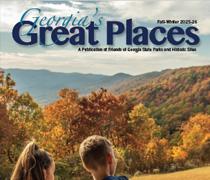Palmetto Trail
This 1.5-mile trail highlights south Georgia’s pine flatwoods, one of the most endangered ecosystems in the world. Its plants and animals are well adapted to periodic fires that maintain a habitat dominated by longleaf pine, saw palmetto and wiregrass. The open woods are ideal for watching bluebirds, nuthatch, osprey, woodpeckers, warblers and other birds. Gopher tortoises and endangered indigo snakes depend on this habitat for survival. Look for fruit-bearing plants such as blueberries, muscadine grapes, sparkleberry, wax myrtle and gull berry.
Sempervirens Trail
These old-growth hardwoods give the trail its name, which is Latin for “ever living.” Large oaks, cherries and hickories make up the canopy along the nature loop portion of the trail. These are nurtured by calcium-rich soil, which was created by decomposed oyster shells left by Native Americans. This trail boasts five Georgia Champion Trees: the staggerbush lyonia, Florida soapberry, myrtle oak, chapman oak, and Carolina holly. You may also see Southern magnolia, red cedar, American basswood and yaupon holly. As you leave the dense hardwoods and enter the pine-oak forest, look for gopher tortoises, Georgia’s state reptile. These large turtles dig burrows in sandy soil and feed on small grasses. You may also see raccoons, armadillos, feral hogs and orb weaver spiders. A birding platform makes it easier to spot great egrets, great blue herons, osprey, pileated woodpeckers, white-eyed vireo and warblers.
River Trail
This trail is short and sweet. Only a few hundred yards long it winds along the bluff and down into the marsh. It is a beautiful spot for fishing and bird watching. Wood Storks and herons roost in the dead pines overlooking the rivers edge. Sheepshead, Whiting, Trout, Black Drum, rays and small sharks can be caught from the shore. This quiet spot overlooks the Crooked River and golden marsh grasses which are famous to Georgia’s coast.
Bay Boardwalk Trail
A boardwalk leads to a hardwood and evergreen wetland dominated by two tree species: loblolly bay and swamp bay. Even during winter, this forest appears to be a wall of dark green, dense foliage. Typical south Georgia swamps contain cypress and gum trees that appear bare during colder months. Even during summer, the shade along this trail is noticeably cooler and more humid than other areas.
Although the creek bottom appears mucky, its water is surprisingly clear, coming from rainfall and seepage from the surrounding sandy soil. Decaying trees and leaf litter on the ground form a layer of peat that can be many feet thick. This soil is strongly acidic, high in organic material and holds water like a sponge. Because of this ability, the forest floor does not support fire except during extreme drought conditions.
Common trees and plants in the bay forest include loblolly bay, swamp bay, tulip poplar, water oak, red maple, sweet gum, swamp and water tupelo, cinnamon fern, netted chain fern, climbing hydrangea, muscadine grapes, fetterbrush lyonia and wax myrtle. Look for small ferns in the trees that appear dead during dry weather and alive after it has rained. This is called resurrection fern. Birders may spot red-bellied woodpecker, pileated woodpecker, flicker, sapsucker, yellowthroat warbler, pine warbler, Northern parula warbler, yellow-rumped warbler, nuthatch, great crested flycatcher, Acadian flycatcher, barred owl, great horned owl, red-tailed hawk, and migratory songbirds and raptors.















